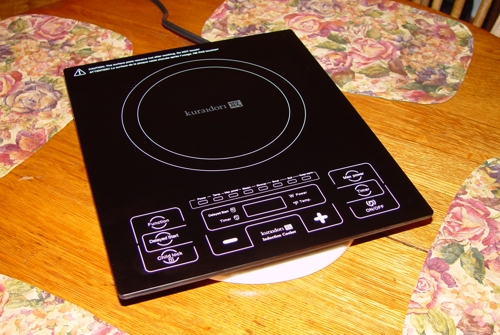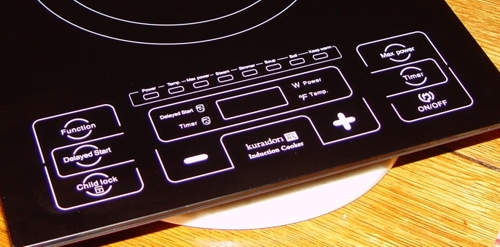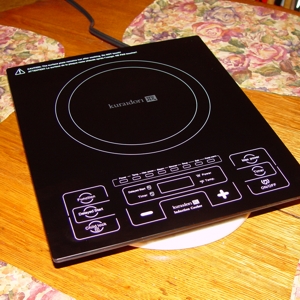If you watch The FOOD Network in Canada or the U.S., you’ve almost certainly heard about the Kuraidori Portable Induction Cooktop. How fitting that Holiday advertising for this futuristic – almost magical – gadget has been ramping up to a fever pitch surpassed only by the new Star Wars Movie!
 The Kuraidori Portable Induction Cooktop: Weighs a respectable 3 kg / 6.6 lb,
The Kuraidori Portable Induction Cooktop: Weighs a respectable 3 kg / 6.6 lb,
and measures 15 in. x 12.5 in. / 37.5 cm x 31.25 cm (plus a minimum
clearance on all sides of 4 in. / 10 cm). Works anywhere there’s a
120 volt household outlet – even right on the dining table!
They say the Kuraidori Induction Cooktop can cook just about anything, anywhere there’s a regular 120 volt household electrical outlet. They say it can boil water faster than any conventional stovetop burner, be it electric or gas. They say it’s ideal for every kind of cooking.
Well, my dear sweet Mom gave me one as an early Christmas present and I’ve been tinkering with it almost constantly for the past couple of days learning a whole new approach to applying heat to food.
Can your stovetop element do this?
The induction cooktop offers some nifty features that no regular stovetop burner can match. You can actually set the heat to pre-set cooking temperatures ideal for specific cooking chores – the ‘Keep Warm’ option is accompanied by options such as ‘Boil’, ‘Simmer’, ‘Soup’ (and stock) and others. It also lets you set the heat by Temperature – like a digital oven control – from 160 F to a full 450 F. That lets you use the thing as a buffet table warming stand or a deep frying station – and just about everything in between.
 Every control and option you could ever want. I think. Even a Child Lock button,
Every control and option you could ever want. I think. Even a Child Lock button,
because the slightest touch of the surface controls is detected
and acted upon by the Cooktop.
Does it really boil water faster than conventional stovetop burners? Not as fast as I’d like. I timed a large put with two litres of plain water starting at cold-out-of-the-tap temperature. It took 11 minutes to come to a rolling boil – which is, indeed, better than average performance. But I’ll admit that, like many cooks, I’m the impatient type when it comes to waiting for pots and pans to heat up.
How it works…
Unless you’ve been living in a remote jungle village on the Amazon, you will already be familiar with the Microwave oven. Microwave cooking works by broadcasting radio waves into the food. These waves ‘excite’ the water molecules (and some other substances) in the food, generating heat which cooks the food. This inside-out cooking technique works better for some foods than others.
Induction cooking is somewhat similar, in some respects, but quite different in others. Induction cookers generate a strong electromagnetic field which excites molecules in the cookware, not the food. Like microwave cooking, this ‘excitation’ causes the cookware to heat up, cooking the food.
Also, because it’s the cookware that heats up and not the cooktop itself, you don’t have to contend with baked-on spills and boil-overs. That, I particularly like!
The potential dangers associated with microwaves are not present with induction cooking, But induction has its own issues. Give induction cookers a wide berth if you have a pacemaker or have any other magnetic materials in or on your body!
Some caveats…
All cookware you want to use with an induction cooker must be magnetic. That is, it a magnet must stick to it. That proves that the metal has enough iron in it to capture the electromagnetic waves and turn them into heat. Cast iron is best; it’s pure iron. Some stainless steel pots and pans may work, but many do not. I’ve tested every pot and pan in the kitchen and this rule of thumb seems to apply: The shinier the pot, the less likely it is that a magnet will stick. This is probably because stainless steel is an alloy of steel, nickel and chrome. The shinier the pan, the less iron and the more non-magnetic material there is in the mix. Fortunately, the Kuraidori Cooktop comes with a handy magnet to test cookware in the home or at the store, before buying it.
Aluminum and ceramic cookware are useless on an induction cooktop.
Uneven pot/pan bottom?
In addition, if the pot or pan you’re using is not perfectly flat on the bottom or has any surface texture or grooves in it, the unit may detect an error and shut off. Don’t freak out. it’s a safety feature: that’s ‘E6’ in the user manual. No harm will come to the food, cookware or Cooktop.
Empty pot?
The Kuraidori Induction Cooktop (don’t know about others) includes another safety feature that may cause some frustration and consternation for some cooks. The Cooktop detects when a pot boils dry and automatically shuts off. This can be a nuisance when you are trying to do something that requires just a little oil or no lubricant at all, such as baking flat breads or toasting spices.
I haven’t tried the Kuraidori Induction Cooktop with a stovetop grill pan, crèpe pan or other flat minimally-greased cookware.
And, it’s portable!
Yup. The icing on the cake. unlike coinventiuonal stovetop burners, the Induction Cooktop is portable. As we saud before, all it needs is a regular (unshared) 120 volt household wall outlet. Think of the possibilities!
So… If you find an Induction Cooker of any sort under the tree this Christmas, rejoice! It’s a good thing!
~ Maggie J.

